No products in the cart.
Return To ShopWondering how you can improve your short game? Top teacher Tom Stickney provides a shot guide that the pros have mastered.
Getty Images
I’ve recently talked candidly about my struggles with my short game, with way too many unnecessary strokes being added to my scorecard due to mishits around the putting surface.
While this is expected from a mid-handicapper like myself who only has time to play a couple of times per month (if that), it’s still frustrating not being able to hit the shots I need to.
But here’s the thing: Just because you’re within 20-30 yards of the green doesn’t mean you can’t be a little bit more creative with what short-game shots you can hit. So instead of always grabbing a lob wedge and risking a chunked or skulled result, maybe try using a Texas wedge for a safer play?
What’s awesome about golf is that there’s no one-size-fits-all approach — which is why we see so many pros succeed around the greens. Given their creativity and soft touch, they closely analyze each shot before landing on their club choice and shot type, then they go execute their strategy to perfection.
So which shots are important to add to your arsenal? Top teacher Tom Stickney provides six creative options below.
A guide for improving your short-game shots
“If it feels like Tour players have a slew of short game shots in their bag, it’s because they work on all sorts of scenarios when around the green,” Stickney says. “So their greatest asset is using their experience and knowledge to pick a shot, then use the perfect trajectory that works best for them within that situation.”
Stickney says that too many amateurs get “stuck” with only one option in the short game, which handicaps them when conditions don’t allow for that type of shot.
“You must have the ability to hit several different shots of varying height,” he says. “If you have a limited number of shots around the green, then you’ll never develop a dependable short game that can take you to another level as a player.”
That’s why he says the six short-game shots below should be a good starting point to help expand your repertoire, leading to lower scores in no time.
1. The Texas wedge
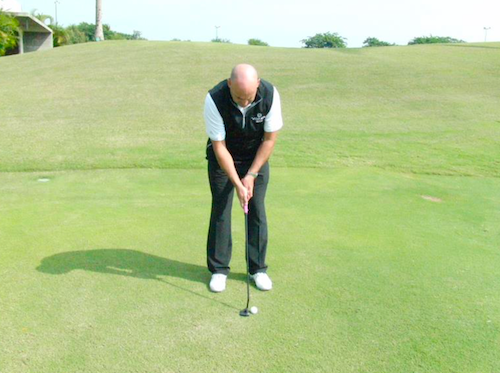
Tom Stickney
The Texas Wedge is a popular choice for when the ground gets hard and baked out, making chipping and pitching dangerous. This shot with the putter is a safe option to help get you close to the hole, with it likely being the easiest shot to play in golf.
How to hit it: Position the ball as you normally would for putting, and set 60 percent of your weight forward to ensure a good stroke. Now allow the putter to move and accelerate through the ball, using a “short to long” stroke without any wrist action — which keeps the putter head moving through the ball. The key to executing this shot is to simply make sure you hit the ball hard enough, making sure it just ends up somewhere on the green (in the worse-case scenario).
2. Putter back in stance
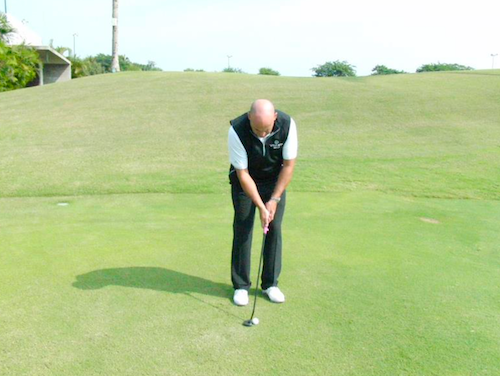
Tom Stickney
As stated above, when all else fails, the putter is always the best choice. But what happens if you have a bad lie or longer distance to go, or even some rough in front of you? This is the time where you need more speed to get the ball through the stuff in front of you, but not for the ball to take off once it hits the green.
In times like these, I suggest just positioning the ball back in your stance when using the putter off the green — which still gives you all the benefits of using the Texas wedge.
How to hit it: Position the ball just on the trail side of your sternum, with 60 percent of your weight on your forward foot. Next, lean the shaft of the putter forward so that the butt of the club points at your front pocket. This position will ensure that the putter moves correctly.
The setup will cause the putter head to move just slightly upwards during the backstroke, allowing you to move down and through the ball during impact. This no-wrist stroke will also cause the ball to pop up in the air slightly, producing a touch more topspin than a regular Texas wedge.
3. Fairway wood or rescue club
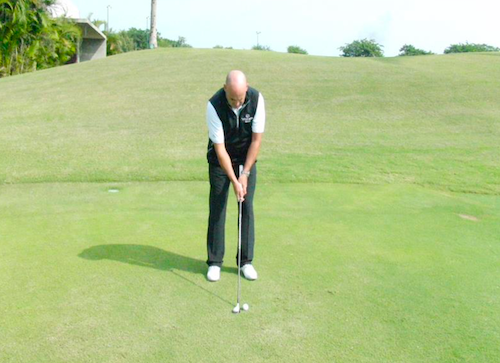
Tom Stickney
Using either a fairway wood or rescue club (hybrid) from just off the green allows you a very easy way to get up and down from good, bad or tight lies — especially when a pin is close to the edge of the green.
How to hit it: Set up to your fairway wood or rescue club as you normally would, and choke all the way down to the end of the grip next to the shaft. Now assume your normal putting grip, and use your typical putting stroke without any wrist action. By doing this, you’ll allow for the extra mass and length of the wood (or hybrid) to propel the ball onto the green.
I recommend only using this shot on very tight pin placements next to the edge of the green, because longer shots require different fundamentals.
4. Bellied wedge
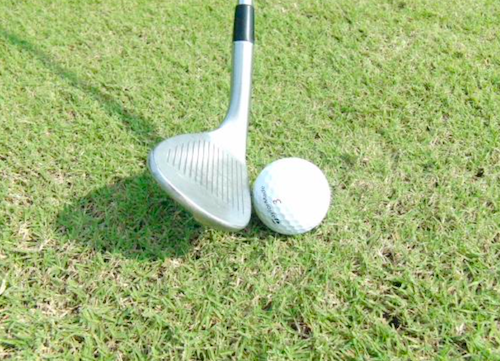
Tom Stickney
Using a bellied wedge is great for really “touchy” shots from just off the green, when a putter or a rescue club won’t work. It’s also great from just about any lie, whether good or bad.
By using the extra mass of a sand wedge and the thick flange of the sole, you’ll find that the ball has a quick burst of topspin — helping it to roll true once it hits the green, and preventing it from getting away from you.
How to hit it: Position the ball in the middle of your stance, just like you’re using a putter. Weight should be 50-50, and you should use your normal putting grip. Now keep your wrists firm and impact the ball in the belly or equator of the ball, causing it to roll on the top of the grass and then gently onto the green.
5. A bump and run
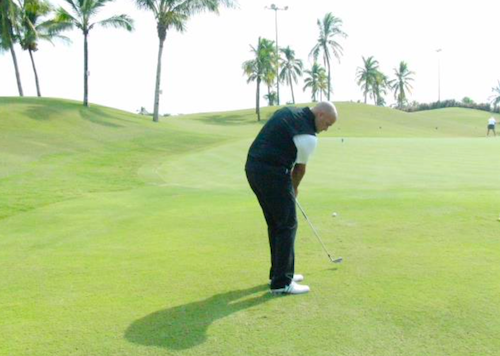
Tom Stickney
A bump and run is a common short game shot for most amateurs, and can be a great option when you’re too far from the pin to use a putter, a rescue shot, or even a chip shot. While most irons are possible club choices for a bump and run, something between a 7-iron and a 9-iron are usually most popular.
How to hit it: Place the ball back in your stance and just between your sternum and your trail toe (depending on the length of the shot). All your weight should be positioned on the lead side, with the clubshaft and hands being pushed forward — so that the butt of the club points to your forward pocket. If you look down and notice a lowercase “Y” formed between your arms, hands, and clubshaft, you’re in the right position.
Now lock in your wrists with the weight forward while making your putting stroke, keeping the “Y” intact all the way through.
6. A toe-down pitch shot
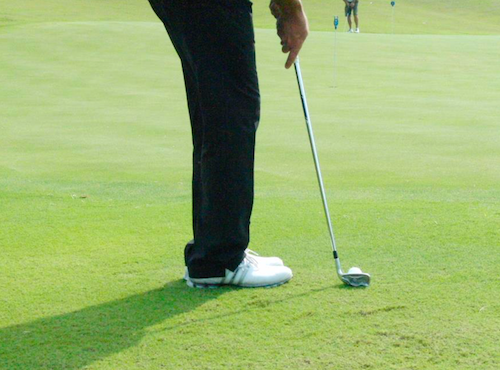
Tom Stickney
With so many golf courses now mowing greens to be super fast, it probably seems like any time you miss a green by 5-10 feet you’re faced with a near-impossible shot. It’s in moments like this when a toe-down pitch shot can be beneficial.
How to hit it: Set the club down on its toe (with the heel off the ground), place the clubshaft perpendicular to the ground, and place the ball in the middle to the back of your stance. Next, use your normal putting grip and normal putting motion (with no wrists), allowing the club to go down and through the ball during impact.
This type of shot also offers some versatility, so you can either open the blade or close the blade, and use this short-game shot on all different types of lies when you’re hoping for a little more roll-out.

Divot Board
$99.99
Introducing the Divot Board, your ultimate golfing companion for immediate feedback and swing correction. This game-changing board reads your divots, providing real-time data on ball flight and helping you improve your technique. Experience the power of instant feedback and elevate your game with this portable and user-friendly device. Perfect for golfers of all levels. Get the Divot Board and take your golfing journey to new heights.
View Product


Nick Dimengo
Golf.com Editor
About author
Related posts
By: Jack Hirsh November 4, 2024 The author’s customized Hazy Sticks. Jack Hirsh/GOLF While this week might be a tough time to be a Nittany... Continue reading
By: Nick Dimengo November 4, 2024 Rickie Fowler gives you the tips you need to execute the ideal flop shot. Getty Images Let’s be honest... Continue reading
By: Dylan Dethier November 4, 2024 Rory McIlroy, Tiger Woods, Nelly Korda, Keegan Bradley, Rory McIlroy, Adam Scott, Tyrrell Hatton, Charley Hull (clockwise from top... Continue reading
By: Zephyr Melton November 4, 2024 Follow Lefty’s advice to fix your chipping. Getty Images Welcome to Play Smart, a regular GOLF.com game-improvement column that will help you become a... Continue reading
By: Josh Sens November 4, 2024 With county approval granted, the Keiser family will build on a portfolio that includes properties in Oregon, Wisconsin, Texas... Continue reading









Add comment